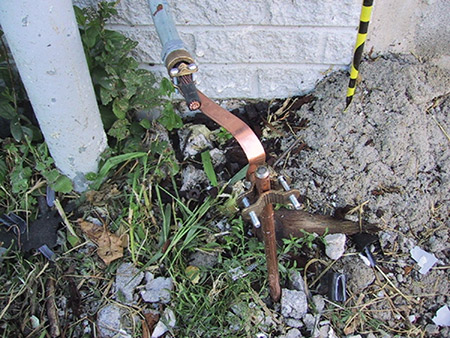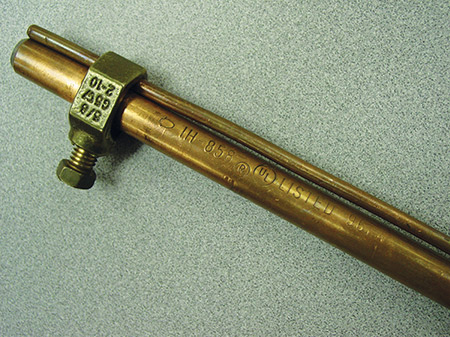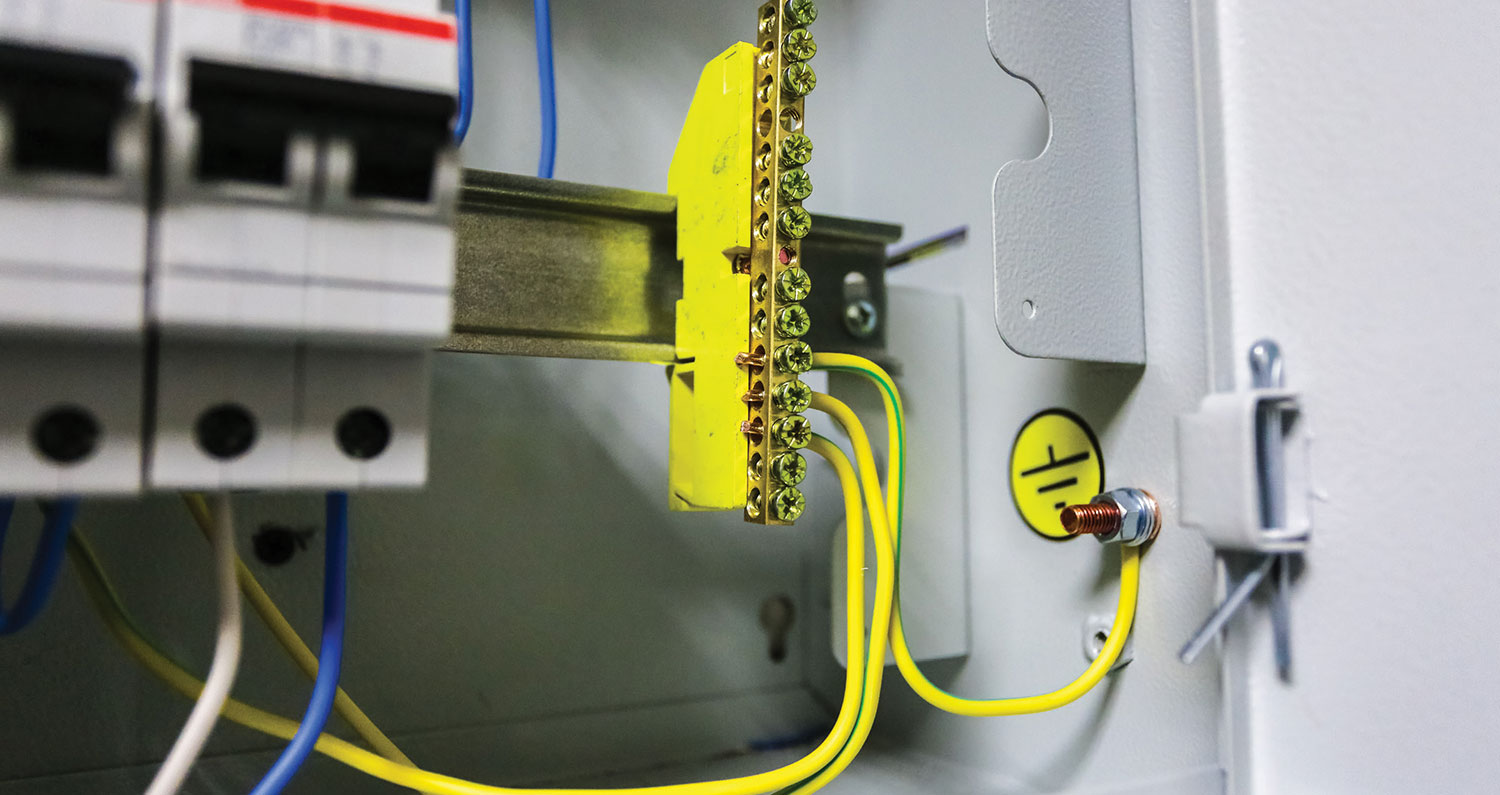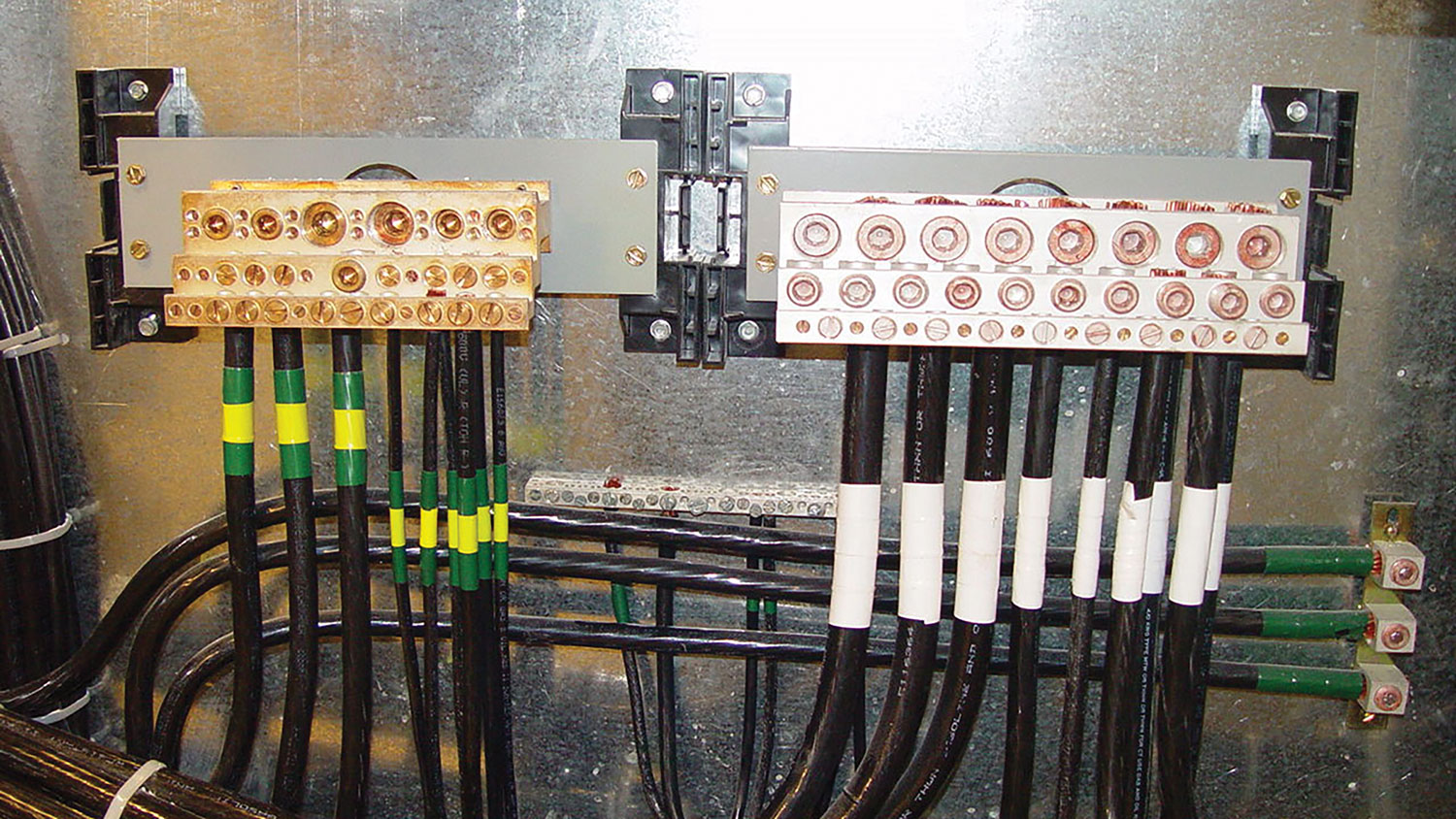Quite often Code users ask, “Is there a difference between a grounding conductor and ground grid conductor?” Or, “Is there a difference between a grounding electrode and a station ground electrode?” And, “If there is a difference, how does such difference impact on a need to connect metal parts of non-electrical equipment to a grounding conductor?”
These are valid questions, as the CE Code terminology in this regard certainly leaves room for improvement.
So, let’s review the relevant terminology of the CE Code on this subject. General terminology on grounding is provided in Section 0 definitions of the Code. These definitions are shown below, and they are applicable throughout the Code.
“Ground– a connection to earth obtained by a grounding electrode.
Grounding – a permanent and continuous conductive path to the earth with sufficient ampacity to carry any fault current liable to be imposed on it, and of a sufficiently low impedance to limit the voltage rise above ground and to facilitate the operation of the protective devices in the circuit.
Grounding conductor – the conductor used to connect the service equipment or system to the grounding electrode (see Appendix B).
Grounding electrode – a buried metal water-piping system or metal object or device buried in, or driven into, the ground to which a grounding conductor is electrically and mechanically connected.
Grounding system – all conductors, clamps, ground clips, ground plates or pipes, and ground electrodes by means of which the electrical installation is grounded.”
All these definitions present a clear picture of a complete grounding system – a very particular entity, where a grounding conductor is connected between a service equipment and a grounding electrode (or between the grounded service conductor of a grounded electrical system and a grounding electrode), and where a grounding electrode is a specific metal object in a reliable contact with earth.
It is interesting to note that Appendix B on definition grounding conductor offers the following clarification:
“Grounding conductor
It is intended that the grounding conductor will terminate on the enclosure for the service box or protective devices supplying the system in cases where the system is not grounded, and at the internal bus for the grounded conductor where the system is grounded.”
This clarification is significant, as it explains that connection to a grounding electrode should be made only:
In the bus installed in the service entrance compartment of the service equipment for the purpose of termination of the grounded service conductor, where the electrical supply source is grounded, or at the metal enclosure of the service equipment, where the electrical supply source is not grounded.
As it was mentioned at the outset of this article, this CE Code terminology applies through all requirements of the Code, but it is particularly utilized in conjunction with requirements of Section 10 that covers grounding and bonding.
For the purpose of our discussion, we’ll concentrate on two specific rules of this section: Rule 10-700 which governs installation of grounding electrodes, and Rule 10-406 that describes conditions under which metal parts of non-electrical equipment must be connected to a grounding conductor. Let’s start with Rule 10-700 and see that this Rule identifies three types of grounding electrodes (manufactured, field-assembled, and in-situ electrodes) and sets out requirements for their installation. In light of the fact that the majority of the electrical contractors use manufactured rod and plate electrodes, only requirements for installation of these electrodes are shown below:
“10-700 Grounding electrodes (see Appendix B)
(1) Grounding electrodes shall consist of
(a) manufactured grounding electrodes;
(b) field-assembled grounding electrodes installed in accordance with this Rule; or
(c) in-situ grounding electrodes forming part of existing infrastructure as defined in this Rule.
(2) Manufactured grounding electrodes shall
(a) in the case of a rod grounding electrode, consist of 2 rod electrodes (except for a chemically charged rod electrode where only one need be installed) spaced no less than 3 m apart,
(i) bonded together with a grounding conductor sized in accordance with Rule 10-812; and
(ii) driven to the full length of the rod; or
(b) in the case of a plate electrode, be
(i) in direct contact with exterior soil at no less than 600 mm below grade level; or
(ii) encased within the bottom 50 mm of a concrete foundation footing in direct contact with the earth at not less than 600 mm below finished grade.”
It is obvious from this requirement that the Code does not prescribe the dimensions of the rod or plate electrodes, as these electrodes represent a standard grounding equipment that is designed, constructed, tested, marked and certified in conformance with the CSA standard C22.2 No. 41 “Grounding and Bonding Equipment.”

Photo 1. Is a metal fence required to be grounded?
These types of electrodes could be purchased from a supplier accordingly. So when an electrical contractor purchases standard rod or plate electrodes, these electrodes must be installed in compliance with Rule 10-700(2) above, and the dimensions of these grounding electrodes would be determined by the standard for these specific types of electrodes.
So far, it is clear that a metal object that is designed and constructed for the purpose of establishing a reliable contact with earth, is defined as grounding electrode, and a conductor intended for connection to the grounding electrode is the Code defined grounding conductor.
Let’s now take a look at the CE Code requirements for connection of metal parts of non-electrical equipment to a grounding electrode.
Rule 10-406 mandates the following:
10-406 Non-electrical equipment (see Appendix B)
(1) The following metal parts of non-electrical equipment shall be bonded to ground:
(a) frames and tracks of electrically operated cranes;
(b) the metal frame of a non-electrically driven elevator car to which electric conductors are attached;
(c) hand-operated metal shifting ropes or cables of electric elevators;
(d) metal enclosures such as partitions, grille work, etc., around equipment carrying voltages in excess of 750 V between conductors; and
(e) tower and station structures of passenger ropeways, passenger conveyors, or material ropeways.
(2) Where a metal water piping system is installed in a building supplied with electric power and is not used as a grounding electrode required by Rule 10-700,
(a) the metal water piping system shall be bonded to the system grounding conductor by means of a copper bonding conductor not smaller than No. 6 AWG; and
(b) the bonding conductor shall be attached to the metal water piping system
(i) at a location as near to the consumer’s electrical service entrance as is practicable; and
(ii) at a location where a feeder enters a barn or other building.
(3) Each continuous metal waste water piping system installed in a building supplied with electric power shall be bonded to the system grounding conductor or to the grounded metal water supply piping by a copper bonding jumper of not less than No. 6 AWG.
(4) All interior metal gas piping that may become energized shall be made electrically continuous and shall be bonded in accordance with the requirements of Subrule (2).
(5) In buildings housing livestock, all metal water pipes, stanchions, water bowls, vacuum lines, and other metals that could become energized shall be bonded to ground by a separate stranded copper bonding conductor not smaller than No. 6 AWG except that, where it is necessary to control the effects of stray earth current, a device specifically approved for the purpose, connected in series with the bonding conductor, shall be permitted.
(6) In rooms that have raised floors of conductive material with electrical wiring under the raised floor, the raised floor assembly shall be bonded with a conductor no smaller than No. 6 AWG copper or the equivalent, in such a manner that the metallic flooring panels or materials form an effective equipotential plane.”
The safety objective of this rule is very transparent, and this rule specifically mandates bonding to ground of metal parts of such industrial non-electrical equipment where presence of arcing or dangerous voltages on such metal parts is feasible. This rule also mandates such connection of metal water piping to a grounding conductor where this metal water piping is not used as a grounding (in-situ type) electrode. This requirement is based on the fact that such metal water pipe could inadvertently become energized and, in this case, the pipe should be connected to the grounding conductor of the electrical system in the building, in order to be kept at the same potential as the grounding electrode.

Photo 2. Is this a bonding or grounding conductor?
The similar objective is behind the requirements of this rule for connection of metal waste water piping, gas metal piping and metal assembly of a raised floor with electrical wiring under such raised floor to the system grounding conductor, as a possibility of a shock hazard due to difference in potential between these metal parts and ground is quite tangible.
Now, it is the appropriate time to look at other definitions used in the Code in respect to the questions posed at the outset of this article. As it was noted, the definitions described above are applicable throughout the CE Code.
However, the CE Code contains a dedicated section (section 36) that covers requirements for High Voltage installations.
Section 36 offers additional special terminology applicable only within the scope of this particular section as follows:
“Boundary fence – a fence forming the boundary of a property or area, but not part of a station fence enclosure.
Ground grid conductor – the horizontally buried conductor used for interconnecting ground rods or similar equipment that form the station ground electrode.
Maximum ground fault current – the magnitude of the greatest fault current that could flow between the grounding grid and the surrounding earth during the life of the installation.
Potential rise of ground grid – the product of the ground grid resistance and the maximum ground fault current that flows between the station ground grid and the remote earth.
Station – an assemblage of equipment at one place, including any necessary housing, for the conversion or transformation of electrical energy and for connection between two or more circuits.
Step voltage – the potential difference between two points on the earth’s surface separated by a distance of one pace, assumed to be 1 m in the direction of maximum voltage gradient.
Touch voltage – the potential difference between a grounded metal structure and a point on the earth’s surface separated by a distance equal to normal maximum horizontal reach.”
It could be seen that all these additional definitions in the High Voltage Section of the CE Code relate to a need to ensure that a potential rise of a station (GPR) does not exceed the tolerable step and touch voltages specified in Table 52 of the CE Code during the lifetime of the station. Although the definition of station ground electrode appears to be absent from the special terminology of Section 36, it could be also seen from the applicable requirements of Section 36 that a station ground electrode is interconnection between the ground grid conductors and ground rods. Ground grids are installed at a depth such that the currents flowing in from the above grade steel structures or shield wire(s) are easily dissipated into the earth. This is accomplished by drilling ground rods (at strategic locations) to a depth where the soil resistivity is low and by connecting the ground grid to the rods so that the grid can access the low resistivity soil. Typically, the ground grid is installed at 900 mm below grade while the ground rods are driven into the soil to a depth of not less than 3 m. These depths are approximate and vary with design standards of various electric power supply authorities.
It is interesting to note that if Rule 10-700 does not prescribe dimensions of rod or plate electrodes (as the Code relies on use of approved grounding equipment).
However, Rule 36-302 of the CE Code specifically mandates use of the rod electrodes of a minimum described dimensions, requires that the ground grid conductors interconnecting these rod electrodes must be at least No. 2/0 AWG bare copper and states that the station grid conductors must be connected to all non-current- carrying metal parts of equipment and structures, and that these ground grid conductors must form a loop around the equipment required to be grounded, as follows:
36-302 Station ground electrode (see Appendix B)
(1) Every outdoor station shall be grounded by means of a station ground electrode that shall meet the requirements of Rule 36-304 and shall
(a) consist of a minimum of four driven ground rods not less than 3 m long and 19.0 mm in diameter spaced at least the rod length apart and, where practicable, located adjacent to the equipment to be
grounded;
(b) have the ground rods interconnected by ground grid conductors not less than No. 2/0 AWG bare copper buried to a maximum depth of 600 mm below the rough station grade and a minimum depth of 150 mm below the finished station grade; and
(c) have the station ground grid conductors in Item (b) connected to all non-current-carrying metal parts of equipment and structures and shall form a loop around the equipment to be grounded, except that
(i) a portion of the loop shall be permitted to be omitted where an obstacle such as a wall prevents a person from standing on the corresponding side or sides of the equipment; and
(ii) loops formed by the rebar in a reinforced concrete slab are adequate when the rebar members are interconnected and reliably connected to all other parts of the station ground electrode”.
In reading the above requirement, many Code users might struggle to consistently understand the extent of application of 10-406 (1)(d) shown above in conjunction with Rules 36-302 and 36-308. Rule 36-308 governs provisions for connection to the station ground electrode as follows:
“36-308 Connections to the station ground electrode (see Appendix B)
(1) All non-current-carrying metal equipment and structures forming part of the station shall be grounded to the station ground electrode to prevent the buildup of dangerous potential differences between the equipment or structures and the nearby earth.
2) All metal items forming part of the station shall be connected to the station ground electrode as follows:
(a) metal structures:
(i) single columns or pedestal-type (pipe, etc.) structures shall be grounded by a grounding conductor not less than No. 2/0 AWG copper; and
(ii) single and multi-bay structures shall be bonded to ground at each column by a bonding conductor not less than No. 2/0 AWG copper;
(b) apparatus mounted on metallic or non-metallic structures:
(i) tanks or frames of transformers, generators, motors, circuit breakers, reclosers, instrument transformers, switchgear, and other equipment shall be grounded by grounding conductors of not less than No. 2/0 AWG copper;
(ii) metal bases of all gang-operated switches shall be grounded by a grounding conductor of not less than No. 2/0 AWG copper (for switch handles, see Rule 36-310); and
(iii) the grounding of metal bases of single-pole fuse cut-outs and isolating switches on wood structures is optional;
c) lightning arresters:
(i) the lightning arresters shall be connected to the station ground electrode by a conductor of not less than No. 2/0 AWG copper;
(ii) lightning arrester grounding conductors shall be as short, straight, and direct as practicable; and
(iii) where lightning arresters are for the protection of high-voltage cable and cable sheath, the lightning arrester grounding conductor shall be connected to metal potheads and/or metal sheath or armour or shielding of all cables;
(d) a metal water main inside or adjacent to the station ground electrode area shall be grounded by at least one copper conductor of not less than No. 2/0 AWG copper, at intervals not exceeding 12 m;
(e) the non-current-carrying parts of metal equipment, such as
(i) cable sheaths, cable armour, shield, ground wires, potheads, raceways, pipe work, screen guards, and switchboards, shall be grounded by copper conductor of not less than No. 4 AWG;
(ii) meter, instrument, and relay cases, when mounted on insulated panels, shall be grounded by a copper conductor of not less than No. 10 AWG; and
(iii) the metal frame and all exposed metal work on buildings within or forming part of the station, shall be grounded to the station ground electrode by a minimum of No. 2/0 AWG copper in at least two places and at intervals not exceeding 12 m along the building perimeter;
(f) steel rails of railway spur tracks entering an outdoor station ground electrode area shall be connected by a copper conductor of not less than No. 2/0 AWG with the part of the spur track located outside the station ground electrode area properly isolated from the station ground electrode or grounded or both in order that touch voltages along the track not exceed the tolerable values specified in Table 52.”
There is a perception by some Code users that Rule 10-406(1)(d) mandates that metal parts of non-electrical equipment located beyond a HV station must be connected to the station ground electrode. These Code users express concern that the extent of HV station is not applied consistently, particularly when high voltage equipment is not installed in an electrical room (which could be considered to be defined as a station), but is located in a large, wide open, industrial building.
There is no doubt that Section 36 could be (and should be) improved. However, from a practical perspective, every electrical equipment room that contains HV equipment and LV equipment should be considered as HV station, and requirements of Rule 36-308 should apply for connection of metal parts to the station ground electrode.
If the equipment is located outside of a room boundary, compliance with Rule 36-308 for metal enclosures that are more than 1 m away from the defined boundary of a HV station does not appear to be warranted.
But in each particular case, a design engineer should clearly establish boundaries of a HV station and should consult this issue with participating AHJ.
Hopefully, this article clarified the CE Code differences in certain grounding terminology and elevates awareness of the Code requirements for connection of metal parts of non-electrical equipment to grounding conductor.















Find Us on Socials